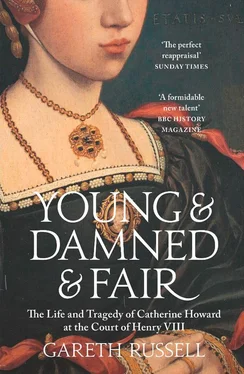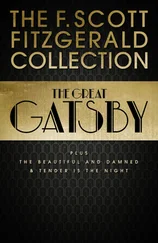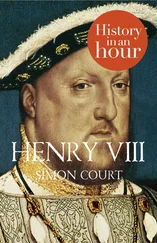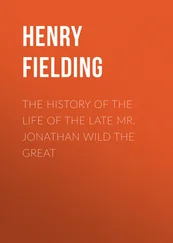In the countryside, beyond the stench and sweat of the crowd assembled to watch Cromwell’s and Hungerford’s deaths, Edmund Bonner, Bishop of London, prepared to preside over the king’s wedding service to Catherine Howard. The pretty palace of Oatlands sat in a rolling deer park, its loveliness marred only by the building work that the king, with his passion for architecture, had ordered three years earlier when the manor had come into his possession.16 A fortune was spent on transforming the seldom-used Oatlands into a retreat fit for the sovereign – an octagonal tower, still a work in progress on the day Cromwell was struck down, was added to the courtyard. Terraced gardens were constructed with multiple fountains, each one an enormous extravagance splashing cooling streams of water. An orchard, its mature trees groaning under the weight of fruit, offered shade to the heads of courtiers and servants, as they endured the stifling heat. The trees were old, but the orchard was not. They had been uprooted from St Peter’s Abbey at nearby Chertsey, a nine-century-old monastery founded by Saint Erkenwald, one of the earliest bishops of London, and brought to grace the king’s gardens when the abbey was shut down, its brothers expelled and its possessions stripped by Cromwell’s inspectors. The stones that built the little palace’s extension had come from the Augustinian priory at Tandridge as it was pulled down to make way for aristocratic demesnes. The price paid by many of his subjects for the king’s religious revolution weighed heavily and silently on Oatlands, but as thick carpets from the Ottoman Empire, chairs upholstered in velvets and cloth of gold, gilt cups, bejewelled table services, and beds hung with cloth of silver were all processed into Oatlands, there was little outward sign of the stresses and tribulation that had gone into making it suitable for the royal household.17
An Oxford graduate in his early forties, Edmund Bonner had risen from relative obscurity, which encouraged accusations that he had been born out of wedlock, to become England’s ambassador to France and, after that, Bishop of London.18 He had secured both his ambassadorship and episcopacy through Thomas Cromwell’s patronage, yet like everybody else he had abandoned Cromwell in his hour of need. The latter’s frantic letters from prison, entreating royal mercy from Henry, written in a disjointed and panicky mess compared to his usual precise calligraphy, had gone unanswered, as Cromwell’s former dependants turned their faces from him, as if he had never existed.
We cannot say for certain where in Oatlands Catherine Howard resided during her wedding visit. Recent excavations of the palace have given us a better picture of its layout and the safest guess would be that her rooms were in the queen’s apartments, located in the palace’s southern towers between the inner and outer courtyards. From any eastern- or western-facing windows above the quadrangle, she would have had beautiful views of either the orchard with its purloined apple trees, the octagonal dovecote or the ornamental gardens circling the fountains. From just above the entrance to the inner courtyard, she would have been able to see the ramp that had recently been installed to help her husband-to-be mount what must have been a particularly sturdy steed. Beyond the walls lay the deer park where she and the king would spend a few days of hunting as part of a ten-day honeymoon.
She was in her late teens, slender, like most of the Howard women, with a ‘very delightful’ appearance, according to the French ambassador.19 The court’s temporary reduction in size and then its removal to the relative obscurity of Oatlands fuelled speculation that she was already pregnant; Catherine’s petite frame gave the lie to the story, but it would be weeks before she was unveiled to the public again and the stories could finally be put to rest.20 Sixteenth-century weddings were not usually romantic occasions and the modern idea of writing one’s own vows or of putting the couple’s affection for one another at the centre of the ceremony would have struck Catherine and her contemporaries as bizarre. It was, like an execution, a formal occasion governed by established precedent; there was a proper way of doing things and as she made her way down to the recently renovated chapel near her husband’s tower to stand in front of Edmund Bonner, Catherine, keen to adhere to etiquette after a lifetime spent learning its nuances, had no intention of making a mistake.
The king had arrived at Oatlands earlier that day. Lucrezia Borgia’s twenty-three-year-old son Francesco, Marquis of Massalombarda, had been visiting London for the last week and he was due to leave that evening; the king had entertained him with visits to his palaces at Greenwich and Richmond and given him two fine horses as a parting gift.21 It was unusual for a traveller to begin a journey in the evening when visibility was poor, so perhaps the marquis had delayed his departure to make sure he witnessed the executions on Tower Hill. If he did attend, his status would have vouchsafed for him a place at the front of the crowd.
Much as a hush falls when a bride enters a church, a silence settled over the spectators as Cromwell began his final speech.22 He delivered it perfectly, thanking God for allowing him to die this way, in full knowledge of what lay ahead, and confessing readily that he was a wretched and miserable sinner who had, like all Christians, fallen short of the standards hoped for by Almighty God: ‘I confess that as God, by His Holy Spirit, instructs us in the truth, so the devil is ready to seduce us – and I have been seduced.’ Then he began to pray – for the king, for ‘that goodly imp’ the heir apparent – and to ask for prayers for himself, though as a reformer he was careful not to ask for prayers for his soul after he was dead but solely ‘so that as long as life remaineth in this flesh, I waiver nothing in my faith’.23
As Catherine, her throat now glittering with pieces from the royal collection, knelt before Edmund Bonner, Cromwell knelt in the sawdust of the scaffold and prayed aloud, ‘O Lord, grant me that when these eyes lose their use, that the eyes of my soul might see Thee. O Lord and father, when this mouth shall lose his use that my heart may say, O Pater, in manus tuas commendo spiritum meum .’24 Hungerford, his sanity now snapped entirely, kept interrupting, writhing and screaming at the executioner to get on with his bloody business.25 Henry Howard, Earl of Surrey, stood at the forefront of the crowd and watched the scene without pity. He was missing his cousin’s wedding to be here to see his family’s bête noire finished off. Later that day, he could not conceal his good mood. It felt to him like a settling of scores: ‘Now is the false churl dead, so ambitious of others’ blood.’26
More of the Howards may have been at Oatlands to help Catherine, steady any nerves and, as ever, offer advice. A few days earlier, in preparation for the wedding, the king had granted Catherine’s eldest brother Charles five properties in London, while their half sister Isabella got a manor house in Wiltshire and all the lands that had once belonged to Malmesbury Abbey. As a gift for performing the service, Bishop Bonner’s debts were paid off by the royal household and he was given a set of gold dining plate that had been confiscated from his predecessor during the dissolutions.27 The newly enriched Isabella, wife to the queen’s vice-chamberlain, was almost certainly in attendance in her capacity both as Catherine’s sister and lady-in-waiting. This was the second queen Isabella would serve and her husband’s fifth. Both were too clever to give any thought to the merry-go-round of queens consort, or rather, any voice. A woman would soon be imprisoned for asking of the king: ‘How many wives will he have?’28
Читать дальше











![John Bruce - The Lettsomian Lectures on Diseases and Disorders of the Heart and Arteries in Middle and Advanced Life [1900-1901]](/books/749387/john-bruce-the-lettsomian-lectures-on-diseases-and-disorders-of-the-heart-and-arteries-in-middle-and-advanced-life-1900-1901-thumb.webp)
